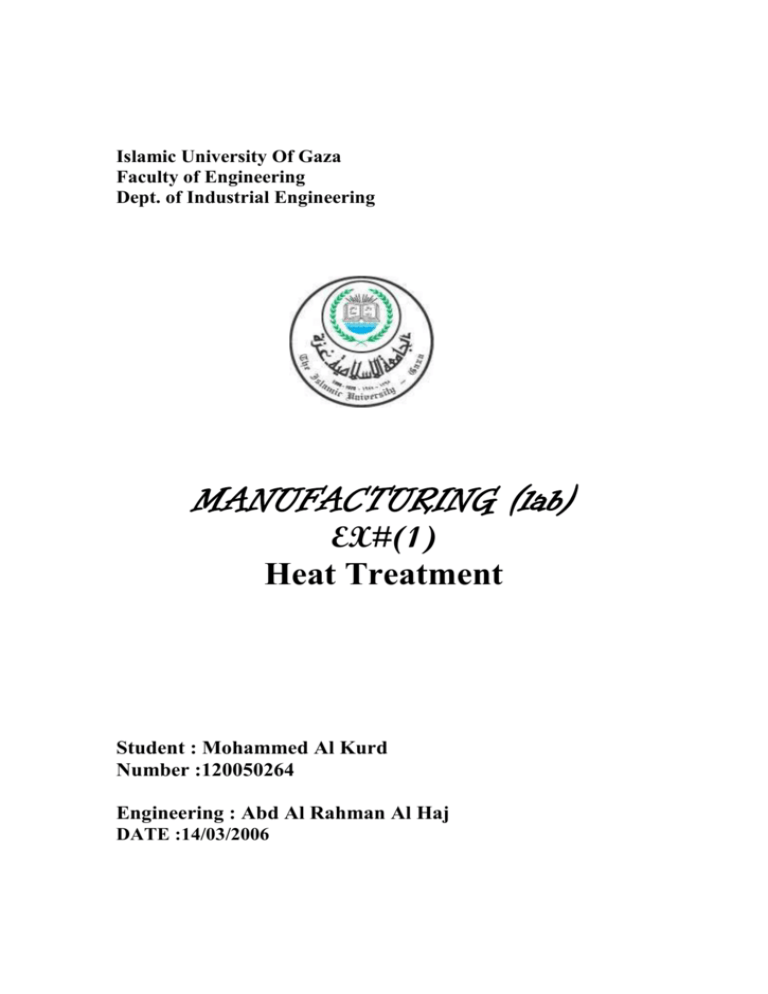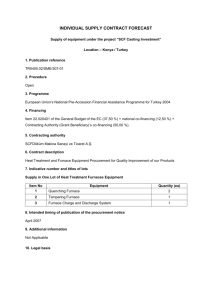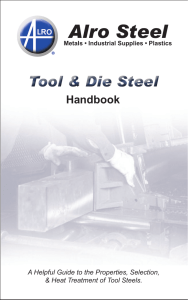Industrial engineering
advertisement

Islamic University Of Gaza Faculty of Engineering Dept. of Industrial Engineering MANUFACTURING (lab) EX#(1) Heat Treatment Student : Mohammed Al Kurd Number :120050264 Engineering : Abd Al Rahman Al Haj DATE :14/03/2006 Contents : List of table ………..…………………………..………...….….3 Abstract ……………...…………………..………...………..….4 Objective …………………………...………………….….……5 Background ……………………...…………………………......5 Procedures ……………………….………………….....……….6 Results ………………………………………….......…………..7 Comment ……….…..……………………………….…...…..…9 List of Tables TABLE 1: hardness reading ………………..………….....…………..7 List of figures Fig1: carbon-iron system ………………………….…………..……..8 Abstract: Heat treatment processes can improve many properties of materials like strength, hardness, ductility, toughness, and resistance to wear. Heat treatment modifies microstructure and , thereby, produces a variety of mechanical properties that are important in mfg such as improved formability and machinability As we know carbon-iron system are composite from Ferrite, Autenite and Cementite Austenite is an important phase in the heat treatment of steels and has maximum solubility of 2.11% C at 1148o C. Austenite is not stable when alloyed by carbon alone below 727o C and nonmagnetic. Objectives: 1. To obtain an understanding of the effects of hardening process (by heat treatment) on certain properties of engineering metals and alloys. 2. To obtain an understanding of the effects that quenching medium and tempering temperature will have on the hardness of hardened parts. Background: Iron is one of the oldest known metals, and carbon is the cheapest and most effective alloying element for hardening iron. Carbon steels account for more than 70% of the tonnage of metallic materials used in the United States for engineering applications. Carbon is added to iron in quantities ranging from 0.04 to 2 wt% to make low, medium, and high carbon steels. The microstructure and resulting mechanical properties of these steels are amenable to modification via heat treatment, and a wide range of mechanical properties can be obtained by proper variations of heating and cooling cycles. Modest amounts (up to a few wt% percent each) of costlier alloying elements such as nickel, chromium, manganese, and molybdynum can be added to the composition, resulting in “low alloy” [content] steels that possess additional desirable properties, including achievability of high strength and good ductility in larger sections. Some common heat treatments for low and medium carbon steels: 1. Austenitize and Air-Cool: This is the typical heat treatment given to the steel by the manufacturer, and is accordingly termed the as received condition. The thermal history leading to this state is also called normalizing. Normalizing of 1045 steel typically consists of the following steps: • Austenitize: put in furnace at 850C in the austenite range, and hold for 1 hour until equilibrium temperature and corresponding solid solution structure have been reached. Air-cool: remove from furnace and allow air-cooling to room temperature. 2. Austenitize and Furnace Cool: This heat treatment is sometimes also called annealing. Here the steel is subjected to the following temperature histories: Austenitize: put in furnace at 850C in the austenite range, and hold for 1 hour until equilibrium temperature and corresponding solid solution structure have been reached. Furnace Cool: slowly cool in the furnace, from 850C to 700C, over a period of 10 hours. Air-cool: remove from furnace and allow air-cooling to room temperature. Austenitize and Quench: Austenitize: put in furnace at 850C in the austenite range, and hold for 1 hour until equilibrium temperature and corresponding solid solution structure have been reached. Quench: Rapidly remove material from furnace, plunge it into a large reservoir of water at ambient temperature, and stir vigorously. For 1045 steel, the quenching medium is water at ambient temperature (for other steels, other quenching media such as oil or brine are used). 3. Austenitize, Quench, and Temper: Austenitize: put in furnace at 850C in the austenite range, and hold for 1 hour until equilibrium temperature has been reached. Quench: Rapidly remove material from furnace, plunge it into a large reservoir of water at ambient temperature, and stir vigorously. Temper: Reheat the steel to the tempering temperature (example: 250C), and hold for approximately 2 hours. Note: there is a range of possible tempering temperatures; for 1045 steel, this range is approximately from 200C to 500C. Different tempering temperatures lead to differences in the resulting mechanical properties; in general, ‘lower’ tempering temperatures lead to high yield strength, but lower toughness and ductility, while ‘higher’ tempering temperatures lower strength, but increase toughness and ductility. Air-cool: remove from furnace and allow air-cooling to room temperature. Each of these thermal histories produces unique microstructural conditions in the steel, and in turn, each microstructural state exhibits a unique combination of mechanical properties. We will perform the heat treatments, and measure the resulting mechanical properties. Procedures: 1. Prepare two reservoirs with water for the first and brine (salt water) for the other. 2. Cut four sample pieces of AISI 1045 carbon steel and mark each piece. 3. Anneal the samples (heat them to austenitizing temperature then turn the furnace off letting them cool slowly inside it). 4. Take the average hardness for each sample. 5. Austenitize the samples again and then quench two of samples in the water medium and the others in the brine. 6. Take the average hardness for each sample. 7. Temper the samples quenched in water at two different temperatures (300, and 500), and do the same with others quenched in brine. 8. Take the average hardness for each sample. Hardness Readings (HRC) for the four specimens which were heat treated in the experiment: Part number Hardness HRC (after annealing)Average HRC Quenching in Hardness HRC Average HRC Tempering at Hardness HRC Average HRC 1 17.3 21.5 20.2 19.7 Brine (8% salt) 58.9 61.6 59.4 60 300 oC 51.2 52.2 55.5 53 4 19.7 20.7 20.8 20.4 Brine (8% salt) 65 65.7 60.8 63.8 300 oC 51.7 51.4 53 52 2 15.5 17.1 15.9 16.2 Water 53.9 51.4 53.9 53.1 3 17.3 17.2 16.9 17.1 Water 50.1 51.9 50.5 50.8 500 oC 43.1 39.7 39.8 40.9 500 oC 38 37.3 39.4 38.2 Conclusion: This experiment is a very important for the industrial , manufacture ,and mechanical engineering because it has a very important principles for the heat treatment process and its applications and methods , the heat treatment process is very large study , but as an start the experiment is give as a very important information’s. There are three types to make material harder: annealing, quenching and normalizing. Annealing is cooling material in the furnace, normalizing is cooling material in the air, quenching is raped cooling of material in flood (Brine, water) but it make crack in material. When we use water only air bubbles will form about apart that make air field about it and we found some bubbles in metal that decrease hardness so we use brine (water, salt) to take out the air. Illustrated in the experiment the part that quenched in water is less hardening than the part that quenched in brine.






